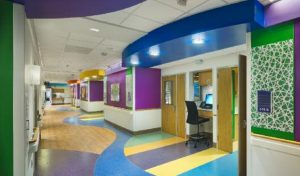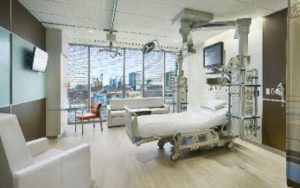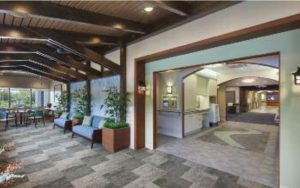Winter 2016
By K.J. Quinn
Remember when much was written and said about how certain floor coverings contributed to “sick building syndrome” in healthcare? It took about 25 years to dispel these notions, but the industry completed a 180-degree turn as research studies indicate soft and hard surfaces actually contribute to improving wellness outcomes for patients while positively impacting the general health of medical facility staff.

“Selecting appropriate materials for a facility is very important,” noted Jim Bistolas, national healthcare segment director, Gerflor USA. “A critical part of that selection process is to evaluate evidence that supports these decisions.”
A mountain of evidence from research studies describes how interior finishes can influence medical outcomes, and reduce errors and waste within healthcare spaces. Fueling significant changes in these selections is the adoption of evidence-based design (EBD), the process of basing design decisions on the built environment and credible research to achieve the best possible outcomes. “Health and wellness, in general, is a huge trend in design now,” said Sara Cederberg, technical director, LEED, at U.S. Green Building Council (USGBC; Washington). “We are getting more evidence-based data — especially in healthcare environments — on how flooring designs can help create a more calming and relaxed environment.”
PATIENT EXPERIENCE SWAYS HEALTHY DESIGN
It would be an understatement to say the impact patients have on hospitals and medical centers is growing significantly. For starters, satisfaction surveys reportedly drive reimbursements and future decisions a healthcare facility may make. “Facility managers and healthcare executives are relying on designers to choose products and plans that will optimize the patient experience,” noted James Johnson, commercial segment manager, Armstrong Flooring. “These decisions help produce revenue not only through government reimbursements but also patient turnover.”

An aging U.S. population is a contributing factor as nearly two-thirds receiving care in emergency departments, hospitals and outpatient settings are age 65-plus, noted Jane Rhode, principal, JSR Associates, Ellicott City, Md. “As a result, facility managers are challenged with budget constraints, reducing risk and promoting safety, as well as a higher awareness of the growing population that needs care.”
Further driving changes in healthcare design are HCAHPS Scores, a national, standardized, publicly reported survey of patients’ perspectives of hospital care. “Designers are more tuned into this than ever,” said Kathy Griffel, director of healthcare, Mannington Commercial. “And the right floor can contribute positively to these scores, particularly around the cleanliness and perceived quietness of the space.”
Patients and their families are much more aware of their surroundings and take this into consideration when choosing facilities for treatment, especially for long-term care. “If healthcare doesn’t adapt to the fact they are a business with clients who chose their respective facilities, then they won’t have any patients,” said Aneetha M. McLellan, NCIDQ, LEED AP BD+C, DLR Group, Omaha, Neb. “By improving the environments in which patient and families operate, the better the outcomes are.”
To that end, the U.S. Department of Veterans Affairs, Veterans Health Administration (VHA) follows Patient Centered Care (PCC) principles in the design of spaces throughout its medical facilities. “VHA plans and supports the overall design of the space to include more natural elements and materials — physical and visual access through materials and finishes,” said Christine Emanuelson Johnson, EPS program manager, interior design. “These elements can play a role in decreasing stress in the patient and family.” VHA reports going to a Patient Aligned Care Team (PACT) design model, which means the patient is the focus of all care and spaces are designed to support VHA care-giver staff.
EVALUATING FLOORING OPTIONS
The impact of flooring decisions has tremendous influence in creating healthcare facilities that are inviting, meet IAQ requirements, support ambulatory and mobility, and reduce noise levels — all of which assist in creating a healing environment. “Safety is primary,” Mannington’s Griffel pointed out. “Not just slip and fall, but also security and comfort underfoot.” Gloss level, for instance, is a key consideration relative to eye fatigue of employees and elderly patients.

Mark Huxta, director of healthcare sales for Ecore, noted research is under way to combat this very issue — how flooring may reduce the risk of injury from patient falls. “The design community has focused a great deal of time and attention on effectively reducing the number of falls, but it is quite clear falls continue to happen,” he said. “The providers recognize this and are looking for products that can reduce the risk of injury from patient falls.” Ecore’s Galaxy rx flooring features a 2-mm vulcanized surface fusion bonded to a recycled rubber backing which not only provides foot fall reductions, but can also significantly reduce fall impact.
Additionally, flooring can impact patient outcomes is by helping reduce acoustic levels inside a facility. Studies show that sleep is critical to patients, especially those struggling to get well. “Designing and building healthcare spaces to provide a soothing, quiet environment has proven to help patients heal faster,” Gerflor’s Bistolas said. “This results in better patient review scores for a facility, which directly impacts their bottom line.” Modular carpet and certain resilient flooring are considered good choices in these public spaces due to their sound control properties.
Facility managers and healthcare administrators have always focused on materials that work well with their maintenance and infection control programs, as cleaning protocols can also affect patient health. For this reason, reducing chemical use is important in all areas. “When an environment doesn’t look maintained, it appears that the facility does not have good care,” DLR Group’s McLellan said. “So maintaining environments have a direct correlation to the quality of care.”
For example, using no-wax products can support the healing process. “Eliminating wax on the floor helps remove harmful VOCs from the environment where immuno-compromised patients reside,” explained Lisa Bonnet, NCIDQ, IIDA, LEED AP, senior interior designer, E4H Architecture, Boston. “The Healthy Hospitals Initiative promotes the use of non-wax flooring products due to the improved indoor air quality they provide.”
VHA considers specifying materials that can be properly cleaned with the least amount of disruption to patients and their caregivers. “Products with longer life cycle costs decrease the need for replacement,” Orest Burdiak, CFM principal interior designer, pointed out. “VHA benchmarks with similar private sector healthcare organizations when considering the master construction specifications for its facilities.”
HEALING: THE SUSTAINABILITY FACTOR
While durability, maintenance and budget are still important when specifying flooring for a healthcare project, the industry is entering a new age where expectations for interior finishes are changing. “It now needs to be about people and not about product,” Ecore’s Huxta said. “It should be about how flooring can enhance the lives of patients, residents and staff.”

Understanding the population whom facility managers are providing care is critical. Flooring solutions, as well as all other design decisions, must respond to the function, safety, lifestyle and values of this demographic. “In senior living residences, for example, social and programmatic areas can no longer be ‘institutional,’ but rather must reflect the needs of the residents,” noted Carol Tobin, principal, Tobin Parnes Design, New York. “Providing environments with material specifications that present a blend of color, texture, patterns and correct lighting can increase the residents’ sense of wellness.”
To that end designers are reportedly fusing functionality and sustainability to create environments designed for comfort, convenience and safety. “When it comes to evaluating products and materials, including flooring, we’re focusing on what’s in the product, how it’s made and the manufacturing process,” USGBC’s Cederberg said. “So we’re using tools like life cycle assessment to understand how much energy and water are used to make the product, does it emit VOCs when in use, has it gone through third-party testing, and are manufacturers transparent about the ingredients in the flooring.”
The VHA Office of Construction & Facilities Management provides master construction standards which are continuously updated with new products and research. For example, “the contents of PG-18-14 are determined by best practices of both private and governmental major healthcare systems,” Burdiak said. “Consideration is given to renewable energy, least disruption to patient care, pre- and post-consumer recycled content, and life cycle costs.”
NEW SOLUTIONS ELEVATE HEALTHCARE’S LOOK, FEEL
In short, industry research supports the idea that floor design contributes to the calming atmosphere of a space and promotes healing. Said USGBC’s Cederberg: “How flooring choices can relate to other materials in a space, how they help ensure safety and beauty at the same time, and how they measure those impacts on healing time, is an emerging topic and one that people are trying to understand better.”
While there are commercial floors with a proven track record in healthcare, innovations across all product types are meeting the needs of this forward-thinking healing design movement.
“Vinyl, particularly of the LVT variety, has evolved to create a resilient solution that does an excellent job at mimicking natural flooring options typically found in residential and hospitality settings, at an affordable cost,” Tobin Parnes Design’s Tobin said.
Indeed, many healthcare facilities are striving to create an atmosphere that’s more home-like and moving away from stark institutional looks, in part due to feedback from their HCAHPS scores. Floor coverings support this trend. “Patients prefer a comforting aesthetic and facilities are feeling the pressure to stay on the forefront of design to remain competitive in their markets,” E4H’s Bonnet said. “We see quite a few of the wood-look visuals. But, the market is being flooded with products that replicate other organic elements, such as stone or fabric as well.”
While natural and organic looks are trending in patient and resident areas, a contemporary spin on design is more requested than a traditional look. “Our audience is much more equipped with a higher design sense today than in the past,” DLR Group’s McLellan explained. “Patients continually see high design environments, and expect the same from their care facilities.”
The appearance of healthcare spaces can also be influenced by geography and culture of the local population. “VHA understands the unique population of our patients,” Johnson said. “Spaces are designed that respect the veterans’ values, preferences and needs.”